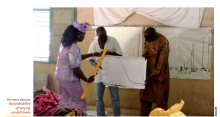Climate change and variability is overwhelming local knowledge and traditions for farm management across Africa. Kaffrine, Senegal’s main agricultural region, has not been spared the scourge.
In the past, Kaffrine farmers recognized the approach of new seasons by the changes in wind direction. The unusual appearance of snakes and frogs or heavy rains preceded by strong wind and dark clouds from a particular direction was an indication of a coming good rainy season while the appearance of dew and higher sky indicated the end of the rainy season.
The regularity of known traditional forecast signs in the Kaffrine were thrown into turmoil the last couple of decades. Since the 1950s, the region has experienced extraordinarily wet conditions, followed by very dry conditions in the 1970s and 1980s. The conditions were made worse by long spells of extreme dry weather at the end of rainy seasons and deluges every couple of years. Onsets of rainfall before the end of the regular harvest season have caused havoc on tons of crops before they could be harvested. Furthermore, early cessation of rain before September, the critical period of flowering, brought heavy losses to millet farmers.
It was in this backdrop that a coalition of stakeholders, including farmers (unions and individual farmers), Senegal’s National Meteorological Agency and Ministry of Agriculture, CGIAR Research Program on Climate Change, Agriculture and Food Security (CCAFS), and others, launched a pilot program with 33 farmers from 6 villages in Kaffrine to produce more accurate and timely seasonal rainfall forecasts, which are then conveyed to farmers as agro-meteorological advisories for specific localities. Therefore, instead of relying on snakes and frogs to sense the monsoon winds that brought the rainy season, Kaffrine farmers rely today on forecast based on satellite readings of monsoons as they form thousands of miles away in the gulf of Guinea, rainfall and temperature information recorded by farmers across the Kaffrine region.
To reach the farmers and facilitate the distribution of information, the Union des Radios Associatives et Communautaires du Sénégal (URAC), an association of 73 community-based radio stations with members stations in all 14 regions of the country is partnering with the Kaffrine project to bring climate advisories to some 2 million farmers all across the country in their local dialects.

